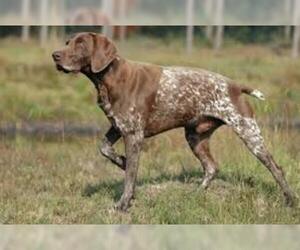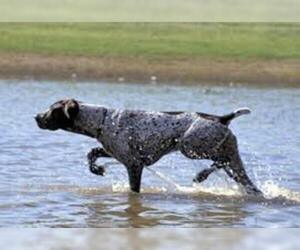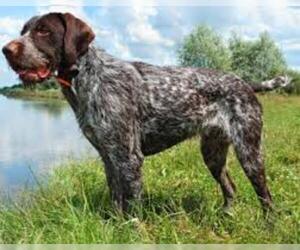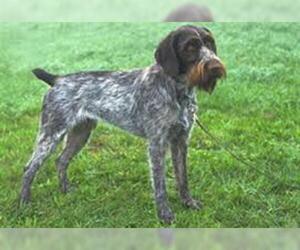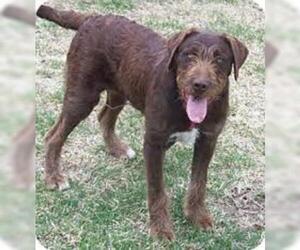
All about German Wirehaired Pointer dog breed
A.K.A. :Drahthaar, German Drahthaar, Deutsch Drahthaar, GWP, Wirehair, German Wirehair, Deutscher Drahthaariger Vorstehhund
Size
Grooming requirements
Exercise requirements
Good with other dogs
Watchdog ability
Energetic
Training requirements
Playful
Affectionate
Good with other pets
Good with children
Good with strangers
Winter
Summer
Healthiness
Protective
Life Span
| Pure Breeds | Member |
| Breeds A - Z | G |
| Breeds by Group | Gun Dog Sporting |
| Breeds by Trait | High Stamina Dog Breeds Low Shedding |
| Overview: | The German Wirehaired Pointer is a versatile and robust hunting dog originating in Germany during the late 19th century. Developed for its all-around capabilities in the field, this breed possesses a distinctive wirery, weather-resistant coat that protects it from harsh conditions and provides excellent camouflage. Physically, they are medium to large-sized dogs with a strong, athletic build, typically weighing between 50-70 pounds. Their alert and intelligent expression is often framed by a moderate beard and bushy eyebrows. Temperamentally, Wirehairs are known for their loyal, eager-to-please, and energetic nature. They form strong bonds with their families and are generally good with children, making them excellent family companions for active households. However, their high energy levels and strong prey drive mean they are not ideally suited for apartment living unless given significant daily exercise and mental stimulation. While generally a healthy breed with a lifespan of 12-14 years, they can be predisposed to conditions such as hip and elbow dysplasia, as well as certain eye conditions. Regular grooming is essential to maintain their coat and prevent matting. |
F.A.Q.
All You Need to Know About the German Wirehaired Pointer Breed
The German Wirehaired Pointer (GWP) is a versatile and robust hunting dog, originating from Germany in the late 19th century. Known for their distinctive wiry coat, this breed boasts a confident, intelligent, and eager-to-please temperament, making them highly trainable. Physically, they are medium to large-sized dogs with a strong, athletic build, perfect for enduring various terrains. GWPs thrive in active households and are generally good with families, though early socialization is crucial. Their high energy levels mean they are not suited for apartment living and require significant daily exercise, including long walks, runs, or mentally stimulating activities. Grooming is relatively low-maintenance, requiring weekly brushing to prevent matting and maintain coat health. Common health considerations include hip and elbow dysplasia, as well as certain eye conditions. Potential adopters should be prepared for an active companion who excels with consistent training and outdoor adventures.The average weight for a German Wirehaired Pointer is between 50-70 pounds. Males typically weigh 60-70 pounds, while females are slightly lighter at 50-60 pounds. This range represents a healthy weight for German Wirehaired Pointer adults, indicating their robust and athletic build. Understanding their average size is key for potential owners.
German Wirehaired Pointer Height: How Tall Is a German Wirehaired Pointer?
When considering a German Wirehaired Pointer, understanding their typical average size and height is important for potential owners. These energetic and versatile hunting dogs have a well-defined standard for their stature.The average height of a German Wirehaired Pointer, measured at the shoulder (withers), generally falls within the range of 24 to 26 inches for males and 22 to 24 inches for females. This means a male German Wirehaired Pointer will typically stand between 24 and 26 inches tall, while a female will be slightly smaller, ranging from 22 to 24 inches.So, to directly answer, the average German Wirehaired Pointer height in inches is approximately 22-26 inches.While these ranges provide a good guideline, it's worth noting that individual genetics and nutrition can lead to slight variations. Some dogs might be a little shorter or taller than the average, but reputable breeders strive to maintain the breed standard. This robust and athletic build allows them to perform their demanding roles in the field effectively.The German Wirehaired Pointer colors primarily recognized by major kennel clubs like the AKC are liver and white (often described as liver roan) and solid liver. These are the standard and most common coat types you'll encounter. The roan pattern can vary from light roan to dark roan, with small or large liver patches. While AKC recognized German Wirehaired Pointer colors are limited to liver and white variations, other exotic German Wirehaired Pointer variations and rare coat types are not accepted and may indicate mixed breeding or non-standard genetics. You will not find "blue," "lilac," "merle," or "chocolate" German Wirehaired Pointers recognized by the AKC or other reputable kennel clubs, and these descriptions are not accurate for the purebred GWP. Potential adopters comparing coat types and pricing should be aware that only liver and white combinations are considered standard and acceptable for the breed.
The German Wirehaired Pointer personality is characterized by a high-energy, intelligent, and devoted nature. These dogs are remarkably friendly and form strong, loyal bonds with their families, thriving on companionship. They possess a good degree of sociability and generally get along well with people and other dogs when properly socialized from a young age.However, their energetic disposition means they are not well-suited for apartment living; they require a home with a yard and owners committed to providing ample exercise and mental stimulation. Their temperament of German Wirehaired Pointer with children is typically excellent, often displaying patience and playfulness, especially with older, respectful kids. With other pets, particularly smaller ones, their strong prey drive can be a factor, so careful introductions and supervision are crucial, especially if not raised together. They are highly adaptable to various activities and training, making them versatile companions for active individuals or families seeking a dog for hunting, hiking, or dog sports.
German Wirehaired Pointer Temperament & PersonalityThe German Wirehaired Pointer temperament is characterized by a high degree of intelligence, unwavering loyalty, and an energetic, enthusiastic nature. They are generally very friendly and outgoing, thriving on human interaction and becoming devoted members of their family.Sociability: GWP's are highly sociable dogs. They enjoy being part of family activities and are often described as "Velcro dogs" due to their desire to be near their people. While not typically aggressive, they possess a strong protective instinct for their loved ones.Apartment Living: Due to their high energy levels and need for regular, vigorous exercise, the German Wirehaired Pointer is not well-suited for apartment living. They thrive in homes with ample outdoor space where they can run and play. Without sufficient mental and physical stimulation, they can become bored and destructive.Children & Other Pets: With proper socialization from a young age, German Wirehaired Pointers are typically excellent with children, often displaying patience and playfulness. Their gentle nature makes them good companions for older, respectful children. When it comes to other pets, particularly cats or smaller animals, their strong prey drive can be a factor. While they can coexist peacefully with other dogs, especially if raised together, careful introductions and supervision are always recommended, particularly with non-canine pets.Stubbornness & Sensitivity: This breed can exhibit a degree of stubbornness, particularly if they perceive a lack of clear leadership. Consistent, positive reinforcement training is essential. They are also sensitive dogs and do not respond well to harsh training methods; gentle, firm, and patient guidance is most effective. Their desire to please, combined with their intelligence, makes them highly trainable with the right approach. Overall, the German Wirehaired Pointer makes an excellent and loving companion dog for active families committed to meeting their needs.
German Wirehaired Pointer Care: Essential Daily MaintenanceGerman Wirehaired Pointers are energetic, intelligent dogs requiring dedicated care. Their unique wiry coat needs weekly brushing to remove loose hair and prevent matting. Occasional hand-stripping (2-3 times a year) is recommended to maintain coat texture and shed dead hair. Exercise is paramount; these are not low-energy dog breeds. They require at least 1-2 hours of vigorous daily exercise, including running, fetch, or field work, to prevent boredom and destructive behaviors. Dietary considerations involve high-quality dog food formulated for active breeds, portion-controlled to prevent obesity. Regularly check and clean their ears to prevent infections. Dental care is crucial; brush teeth several times a week and provide dental chews. While not brachycephalic, their dense coat offers some climate sensitivity, making them suitable for various weather but requiring shelter in extreme heat or cold. Common health concerns include hip and elbow dysplasia, eye conditions, and skin allergies. Regular vet check-ups are essential for early detection. Weight management is key to preventing joint issues. For comprehensive how to care for a German Wirehaired Pointer and health tips for German Wirehaired Pointer, consult your veterinarian.
German Wirehaired Pointer Activity Level: Energetic & DrivenThe German Wirehaired Pointer activity level is high. These dogs are intelligent, athletic, and require significant daily exercise to be happy and well-behaved. They possess a fantastic balance of intensity and ability to relax, often described as an "on/off" switch. While they can enjoy periods of calm indoors, expect them to be ready for action when the opportunity arises.Typical Energy Levels: German Wirehaired Pointers have high energy. They are bred for hunting and have excellent stamina. Without adequate physical and mental stimulation, they can become bored and destructive.Daily Exercise Needs: To meet their exercise needs, a minimum of 60-90 minutes of vigorous activity daily is essential. This can include long walks, runs, hikes, swimming, or off-leash play in a secure area. They excel in canine sports like agility, obedience, and especially field trials or hunt tests, which tap into their natural instincts.Playtime Preferences: They love interactive play! Fetch, retrieving games, and exploring new environments are all favorites. They are keen problem-solvers and enjoy mentally stimulating toys and puzzle feeders.Brachycephalic Limitations: It's crucial to clarify that the German Wirehaired Pointer is NOT a brachycephalic breed. They have a long, well-defined muzzle, which allows for efficient breathing and endurance during strenuous activity. Therefore, they do not have the same breathing limitations or overheating risks associated with truly brachycephalic breeds. This allows them to engage in prolonged exercise without the specific concerns of flat-faced dogs.Balancing Energy and Rest: German Wirehaired Pointers are renowned for their ability to go from high-energy activity to calm rest. After a good workout, they are typically happy to relax by their family's side.Suitability: German Wirehaired Pointers are suitable for active families who enjoy outdoor activities and are committed to providing consistent exercise and training. They thrive in homes where they are considered part of the family and given a "job" to do, whether it's hunting, hiking, or participating in dog sports. They are generally not suitable for low-energy households or those looking for a sedentary companion, as their unmet energy requirements can lead to behavioral issues. If you're wondering how active are German Wirehaired Pointers, the answer is very! Prepare for an engaged, athletic, and loving companion.
Breed Breakdown: What Experts Say About the German Wirehaired Pointer
I'd rate the German Wirehaired Pointer's "Size" trait a 7.This breed is firmly in the medium-to-large category. Males typically stand 24-26 inches at the shoulder and weigh 60-70 pounds, with females slightly smaller. Their body structure is robust and athletic, built for endurance and power. While not a giant breed like a Great Dane, they are significantly larger and more substantial than many common companion dogs such as Beagles or Cocker Spaniels. Compared to a Labrador Retriever, they are often similar in height but can appear more lean and muscular.This size generally makes them not ideal for apartment living, especially without significant daily exercise outlets outside the apartment. Their substantial frame and energetic nature mean they need space to move around comfortably indoors. They are manageable for travel in a car or crate, but their size might make air travel more challenging or expensive due to crate size requirements. Households with space constraints would likely find them too large, as they benefit from a fenced yard and a home where they don't feel cramped. They thrive in homes with ample space, both indoors and out, where their athleticism can be appreciated.
I would rate the German Wirehaired Pointer's "Grooming Requirements" at a 6 out of 10.While not in the extreme high-maintenance category like some double-coated or long-haired breeds, they are certainly not a wash-and-go dog. Their signature dense, wiry coat, which is essential for their field work, requires regular attention to prevent matting and to maintain its protective qualities. Weekly brushing, ideally with a slicker brush and a stripping knife or hand-stripping, is necessary to remove dead hair and promote new growth, especially to maintain the wiry texture. They are moderate to low-hedders, but this regular brushing helps manage what hair they do shed. Their facial furnishings (beard and eyebrows) also need frequent cleaning to prevent food and debris accumulation, which can lead to skin irritation. Ear cleaning is important due to their dropped ears, which can trap moisture and increase the risk of infections. Like all dogs, nail trimming is essential, and bathing is needed periodically when dirty, though not excessively as it can soften their wiry coat. They aren't particularly prone to skin issues or allergies, but neglecting coat care can certainly lead to problems. Therefore, they require consistent, specific grooming efforts to keep their unique coat healthy and functional, making them a moderately easy to care for breed, but one that definitely needs more than just occasional attention compared to many short-haired companion dogs.
I would rate the German Wirehaired Pointer's exercise requirements at an 8.This breed possesses an extremely high energy level and a strong drive to work, inherited from its hunting dog lineage. They are built for sustained movement and have excellent stamina, making them tolerant of long periods of physical activity. Daily activity recommendations are significant, often involving several hours of structured exercise beyond simple walks. While not brachycephalic, their athletic build and deep chests are designed for respiratory efficiency during intense physical exertion. They thrive on activities like running, hiking, swimming, and especially mentally stimulating "work" such as field trials, agility, or extensive scent work. Without structured routines and ample opportunity to burn off energy and engage their minds, German Wirehaired Pointers can become bored, destructive, and even develop behavioral issues. They are not a breed that thrives with minimal activity; rather, they require consistent, vigorous exercise to remain healthy, happy, and mentally stimulated.
Watchdog Ability Rating: 8/10The German Wirehaired Pointer, while not a dedicated guardian breed, possesses a highly effective "watchdog ability" due to a combination of inherent traits. They are typically very alert and aware of their surroundings, often responding to unfamiliar sounds or sights with a distinctive bark. Their territorial instincts are present, though not aggressive, meaning they will generally perceive their home and family as their domain to protect. This leads to a reliable early warning system – a GWP is likely to bark and make their presence known when a stranger approaches or something seems amiss. While they might not be the breed to physically deter a determined intruder without extensive training, their assertive vocalizations and imposing size can certainly act as a significant deterrent, making it clear to potential threats that their presence has been noted. They are far from a passive companion in this regard, consistently providing meaningful and timely alerts in a home environment.
I would rate the "Good with Other Dogs" trait of the German Wirehaired Pointer an 8 out of 10.German Wirehaired Pointers are generally quite sociable and tolerant with other dogs, especially when properly socialized from a young age. They are often playful and enjoy canine companionship, thriving in multi-dog households where their energy can be matched. Their natural hunting instincts typically don't translate into aggression towards other dogs, and they tend to be adaptable to different sizes and energy levels, often adjusting their play style. While generally dog-friendly, like any intelligent and strong-willed breed, they benefit from careful introductions and consistent training to ensure peaceful coexistence, especially with very dominant or submissive individuals. However, the potential for true aggression or dominance is relatively low; most issues arise from lack of appropriate socialization or management rather than inherent incompatibility. They typically do not require extensive or constant supervision when interacting with well-matched canine companions once a bond is established.
I would rate the German Wirehaired Pointer's "Energetic" trait a 9 out of 10.German Wirehaired Pointers are renowned for their incredibly high energy levels, reflecting their heritage as tireless hunting dogs. They possess an exceptional typical activity level, needing significant daily exercise to stay content and prevent destructive behaviors. Their endurance is remarkable; they can go for miles and hours without faltering, making them ideal partners for long hikes, runs, and hunting excursions. Playfulness is a core part of their personality, and they thrive on engaging in vigorous games like fetch, tug-of-war, and chasing. The need for physical stimulation in this breed is paramount; without it, they can become restless, anxious, and destructive. They excel in virtually all outdoor and athletic activities, including agility, flyball, dock diving, and various dog sports. Compared to most other companion dogs, the German Wirehaired Pointer is naturally active to an extreme degree and is definitively not laid-back. It's important to note that the German Wirehaired Pointer is *not* a brachycephalic breed; their long, lean muzzle and efficient respiratory system are perfectly adapted for sustained physical exertion and high stamina, allowing them to tolerate and enjoy strenuous exercise without the breathing difficulties that brachycephalic breeds experience.
I'd rate the German Wirehaired Pointer's "Training Requirements" a 7 out of 10.While intelligent and eager to please their owners, GWP's are also highly energetic, driven, and possess a strong independent streak stemming from their hunting heritage. They are incredibly responsive to commands and positive reinforcement, especially when treats and praise are used consistently, but their attention span can be tested by new scents and sights, requiring a firm hand and engaging training sessions. They are not particularly stubborn, but their desire to follow their nose can sometimes override their desire to follow a command, making consistency absolutely crucial. Without it, they will quickly test boundaries.For these reasons, the GWP is generally not recommended for first-time dog owners unless they are fully committed to understanding the breed's needs and investing significant time and effort into training. They thrive with experienced handling and highly structured routines that channel their intelligence and energy productively. Owners who are inconsistent or fail to provide adequate mental and physical stimulation will likely find themselves with a GWP that develops unwanted behaviors due to boredom and a lack of clear leadership. Early socialization and consistent, positive reinforcement-based training from a young age are essential for shaping them into well-behaved companions.
I'd rate the "Playful" trait of the German Wirehaired Pointer a 7 out of 10.While not quite the non-stop goofball of some retriever breeds, the GWP is far from laid-back. Their high energy, strong prey drive, and intelligence translate into a deep love for interactive games and activities. They are enthusiastic participants in fetch, tug-of-war, and anything that allows them to use their brains and bodies. You'll often find them bringing toys to their owners, nudging for attention, and exhibiting a spirited "let's go!" attitude, especially if there's an opportunity for an outdoor adventure. They thrive on engagement and can become bored and destructive if not given outlets for their playful energy, making them naturally spirited and highly interactive compared to more sedentary companion dogs.
I would rate the German Wirehaired Pointer's "Affectionate" trait at a 7 out of 10.While not overtly "velcro" dogs like some companion breeds, GWP's are deeply devoted and loyal to their families. They thrive on human companionship and will consistently seek to be involved in family activities, often following their loved ones from room to room. Their desire for closeness manifests in leaning against you, resting their head on your lap, or being near you on the couch rather than constant lap-sitting or intense cuddling, though they certainly appreciate a good scratch or belly rub. They are sensitive to their owner's moods and will often try to offer comfort or simply be present. Compared to many working or sporting breeds, they are definitely on the more affectionate side, though their independence and focus on their tasks (real or perceived) means they won't always be literally underfoot. They form strong bonds and are truly a part of the family, desiring and reciprocating affection in a genuine, enduring way.
I'd rate the "Good with Other Pets" trait of the German Wirehaired Pointer a 7 out of 10.While not inherently aggressive, their strong prey drive is a significant factor. With proper socialization from a young age, many GWP's can coexist peacefully with other dogs, often enjoying canine companionship due to their active and social nature. However, their instinct to chase and hunt is potent, making their compatibility with cats and smaller "prey" animals (like rabbits or guinea pigs) more challenging. They can learn to tolerate and even bond with a household cat if raised together and carefully trained, but constant supervision, especially initially, is crucial. Resource guarding is not typically a prominent issue for the breed, but consistent training and clear boundaries are always beneficial. Adaptability in multi-pet households largely depends on the individual dog's early experiences and the owner's commitment to training and management. They are not naturally universally "pet-friendly" in the way some retriever breeds might be, and require dedicated effort and supervision to coexist peacefully with all types of animals, particularly those that trigger their hunting instincts.
Rating: 7/10The German Wirehaired Pointer (GWP) is generally good with children, earning a solid 7. They are intelligent, energetic, and eager to please, which can translate into a playful and engaging companion for older, more respectful children. GWPs possess a good degree of patience and tolerance, especially if properly socialized from a young age. Their natural zest for life makes them keen participants in outdoor games and activities, which can be a wonderful match for active families.However, the "Good with Children" rating isn't a perfect 10 for a few key reasons. While affectionate, they are not inherently "cuddle bugs" and may not be the gentlest or most instinctively tolerant with very young, grabby toddlers. Their high energy levels, if not adequately channeled, could lead to accidental bumps or nips during boisterous play, particularly with small children who might get knocked over. They thrive on clear boundaries and consistent training, which is crucial in a family setting to ensure they understand their place and how to interact respectfully with all members, including kids. Supervision is always recommended, especially with younger children, to teach both the dog and the child appropriate interaction. With proper socialization, training, and supervision, a GWP can be a fantastic and loyal family member for children who understand how to interact with a dog respectfully.
I would rate the German Wirehaired Pointer's "Good with Strangers" trait a 7 out of 10.While inherently loyal and protective of their families, GWPs are generally *not* naturally aloof or unfriendly towards unfamiliar adults. They tend to be curious and observant, often assessing new people before fully engaging. A well-socialized GWP is typically polite and can be quite friendly, accepting attention readily once they've deemed someone non-threatening. They are not prone to excessive barking or aggressive guarding with strangers, though their alert nature means they will likely notice and acknowledge a new presence. Their adaptability in public or guest-filled environments is good, provided they've had sufficient exposure and positive experiences during their formative months. While they aren't the dog who will indiscriminately bound up to every person, they certainly aren't reserved. Their comfort with strangers is more a product of consistent early socialization and a confident owner, rather than an innate need for intensive training to overcome shyness. They are outgoing enough to be comfortable, but retain a working dog's awareness of their surroundings.
The German Wirehaired Pointer would rate an 8 for winter tolerance.This breed possesses a dense, wiry double coat that provides excellent insulation against cold and wet weather, historically developed for hunting in varied European terrains including water. Their medium-to-large size contributes to better heat retention compared to smaller breeds, and they typically have adequate body fat for thermal regulation. Being mesocephalic (not brachycephalic), they don't face the respiratory challenges in cold air that short-nosed breeds do. They are generally robust and energetic, capable of safely enjoying extended outdoor activity in cold climates without an undue risk of hypothermia under normal winter conditions. While they are resilient, in extremely harsh or prolonged sub-zero temperatures, or during periods of inactivity, a coat or extra layer of protection might be beneficial, particularly for older or less active individuals. However, compared to most companion dogs, they are significantly better equipped for winter and require less specialized care, often thriving in conditions that would send other breeds indoors.
I'd rate the German Wirehaired Pointer's "Summer" tolerance at a 6 out of 10. While not exceptionally sensitive to heat like some brachycephalic breeds, their dense, wiry double coat, originally developed for working in varied weather, means they can overheat. They are not brachycephalic, which is a significant advantage in heat regulation compared to breeds with shortened snouts. However, their high energy and drive to be active can lead owners to over-exercise them in warm conditions, increasing the risk of heatstroke. During summer months, they definitely require special care compared to many other companion dogs. Activity levels need to be significantly reduced during the hottest parts of the day, with walks and strenuous exercise relegated to early mornings or late evenings. Access to cool, fresh water is paramount, and they benefit from shade and opportunities to cool off, such as wading pools or a fan. While not typically needing constant climate control indoors, a cool environment is essential for their rest and recovery after any outdoor activity in the heat. They are more resilient than breeds like Bulldogs or Pugs, but less so than a short-coated, single-layer breed with lower activity needs.
Rating: 8The German Wirehaired Pointer (GWP) is generally considered a robust and healthy breed, earning a high rating. They boast a respectable average life expectancy of 12-14 years, which is quite good for a medium-to-large-sized dog. While no breed is entirely free from health concerns, GWPs are not typically plagued by the severe genetic predispositions seen in some other breeds. They are not prone to breathing difficulties, given their athletic build and open muzzles.Common breed-specific issues tend to be manageable. Like many active, larger breeds, they can be susceptible to hip and elbow dysplasia, as well as bloat (gastric dilatation-volvulus). Eye conditions such as progressive retinal atrophy can also occur. However, responsible breeders diligently screen their breeding stock for these conditions, significantly reducing their incidence in the offspring. Skin conditions are not a prominent issue for the GWP.In terms of maintenance, they are generally not considered high-maintenance from a health perspective. Their coarse, wiry coat requires regular brushing but minimal professional grooming. Their high energy levels necessitate ample exercise, which, while a commitment for owners, contributes to their overall physical well-being. With appropriate nutrition, regular exercise, and routine veterinary care, the GWP typically enjoys a long and active life. Compared to many other companion dogs, they are quite hardy and resilient.
I would rate the "Protective" trait of the German Wirehaired Pointer an 8 out of 10.This breed scores highly due to a combination of factors. Their innate alertness, stemming from their hunting background, makes them excellent watchdogs; they are quick to notice and react to anything out of the ordinary. They possess strong territorial instincts, especially within their home environment and with their family, which they consider their "pack." Their loyalty to their owners is unwavering, and this devotion often translates into a desire to keep their loved ones safe. While generally not aggressive without cause, their reaction to strangers can be reserved and watchful, often barking to signal a perceived threat and placing themselves between their family and the unknown. They are certainly capable of offering meaningful protection in a household setting, not just as a deterrent barker, but also as a physically capable and confident dog that would defend its family if necessary. While a loving companion, their strong build, intelligence, and protective instincts elevate them beyond merely a friendly presence to a genuinely capable guardian.
Rating: 8The German Wirehaired Pointer's "Life Span" trait rates an 8. This breed is considered long-lived compared to many other companion dogs, with an average life expectancy of 12 to 14 years, and sometimes even longer. While they can be prone to some health issues like hip and elbow dysplasia, certain eye conditions, and bloat, these are not universally debilitating and responsible breeding practices actively work to minimize their prevalence. With proper nutrition, regular exercise, and preventative veterinary care, GWHPs generally enjoy a healthy and extended lifespan, making them a good choice for those seeking a companion for many years.
German Wirehaired Pointer Dogs for adoptionSee all dogs for adoption
German Wirehaired Pointer BreedersSee all breeders
Similar Dog Breeds for German Wirehaired Pointer
Breed Mixes of German Wirehaired Pointer
Quick Breed Selector 0 - not important, 1 - smallest, 10 - largest
Variants & Mistakes :German Wirehair Pointer, German Wire Haired Pointer, German Wirehairedpointer, German Wirehaired Poiinter, German Wierhaired Pointer, Germn Wirehaired Pointer, Gereman Wirehaired Pointer, German Wirhaired Pointer, German Wirehaire Pointer, German Wirehared Pointer, German Wirehaird Pointer, German Wireheared Pointer, German Wirehaires Pointer, German Wirehairred Pointer, German Wirehaired Pinter, German Wirehaired Ponter, German Wirehaired Pointr, German Wirehaired Pointe, German Wirehared Pinter, German Wirehaired Pointers, German Wire Haired Poiinter, Germian Wirehaired Pointer, Gernam Wirehaired Pointer, Geman Wirehaired Pointer, German Wirehaired Poiner, German Wirehaired Pointter, German Wirehaired Poiter, German Wirehaired Pontier, Germen Wirehaired Pointer, German Wirhaired Ponter, German Wirehaired Pointrer, German Wirehaired Poienter, German Wirehaired Pointeer
